Capable of mid-IR emission at room temperatures, quantum cascade lasers enable laser spectroscopy in the spectral region of strong molecular signatures.
Dr. Christian Mann and Prof. Joachim Wagner, Fraunhofer Institut für Angewandte Festkörperphysik, and Dr. Ulrike Tauer and Dr. Marcus Braun, Fraunhofer Institut für Physikalische Messtechnik
Semiconductor lasers emitting in the mid-infrared spectral range between approximately 4 and 13 μm are attractive for a number of applications, such as trace-gas sensing, production and environmental control, medical diagnostics, and free-space optical communications in the atmospheric transparency windows. Because the fundamental rotational-vibrational transitions of most molecules are in the mid-IR, absorption lines are much stronger there than in the near-IR overtone range, and trace-gas sensing can be performed with higher sensitivity.
Making use of optical detection techniques, conventionally tunable diode laser absorption spectroscopy can map the mid-IR characteristics of the molecules of interest employing interband semiconductor diode lasers based on lead chalcogenides such as PbSrSe or PbEuSe. However, lead chalcogenide lasers have drawbacks, most notably the need to operate at cryogenic temperatures.
Quantum cascade lasers, first demonstrated at AT&T Bell Laboratories in Murray Hill, N.J., in 1994,1 are promising solid-state sources that can overcome these obstacles. Mounted on thermoelectric coolers, the lasers can be operated at room temperature in pulsed mode across the mid-IR spectral range, providing relatively high optical output power, good beam quality and narrow linewidth.
In contrast to conventional, interband semiconductor diode lasers, the laser transitions in a quantum cascade laser occur between quantized energy levels in a series of coupled quantum wells within the conduction band. Because the transition energy is primarily determined by quantum confinement, different transition energies can be realized by adjusting individual layer thicknesses without changing the composition of the constituent materials. This technique, often referred to as bandstructure engineering, offers a wide tuning range of the emitted radiation across the mid-IR, from approximately 3.5 to 24 μm.
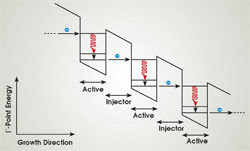
Figure 1. In this simplified conduction band diagram of a quantum cascade laser structure, wavy arrows indicate the laser transition.
Figure 1 shows the simplified conduction band diagram — i.e., the conduction band edge energy (G-point energy) versus growth direction — of a quantum cascade laser structure, consisting of the active and the injector region. The laser transition takes place in the three-level system of the active region. Of course, the structure must be designed such that the lifetime of the upper laser level is much longer than that of the lower laser level so that it may achieve population inversion. For this reason, the lower level is depopulated rapidly by resonant emission of longitudinal optical phonons to a third level, positioned approximately one longitudinal optical phonon’s energy below the lower laser level. From this level, electrons move from the active region into the injector.
Under the appropriate applied electric field, these electrons travel/tunnel through the injector region and can be injected into the upper laser level of a subsequent active region. Cascading several tens of active regions connected by injector regions enhances the optical gain and, thus, reduces the threshold current density at the expense of an increased operating voltage. Employing this cascading scheme, each electron can generate up to N photons, where N is the number of active regions in the structure. In contrast, the recombination of one injected electron-hole pair in a conventional interband diode laser is able to emit only one photon.
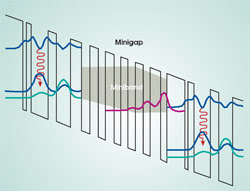
Figure 2. A calculated conduction band profile illustrates two active regions connected by an injector region of a representative quantum cascade laser structure under positive bias conditions. Also shown are the moduli squared of the relevant wave functions and the first miniband of the injector (gray shaded region). Wavy arrows indicate the laser transition.
Figure 2 displays the calculated conduction band profile of two active regions connected by an injector region of a representative quantum cascade laser structure based on the GaInAs/AlInAs-on-InP materials system. Also shown are the moduli squared of the relevant wave functions; wavy arrows indicate the laser transition. The active region comprises three coupled quantum wells separated by barriers. The heterostructure band-offset and the individual layer thicknesses are adjusted to generate the desired laser wavelength and to guarantee that the energy difference between the lower two levels corresponds approximately to the energy of one longitudinal optical phonon. The injector region is composed of a chirped semiconductor superlattice.
In this case, under the appropriate applied electric field, a miniband opens up at the energy of the lower two levels of the active region, enabling electrons to tunnel out of the active region into the injector, where they relax to the miniband’s ground state and are injected into the upper laser level of the subsequent active region. For the electrons in the upper laser level, the injector’s minigap acts as a Bragg reflector, preventing these carriers from tunneling out of the active region and thus further enhancing population inversion.
One active/injector region consists of approximately 20 layers. A quantum cascade laser typically comprises 25 of these regions, so the entire structure consists of about 500 layers, each only 0.9 to 5.0 nm thick. Control of the individual layer thicknesses, the uniformity of the materials’ compositions and the heterostructure interfaces are among the challenges to be met when fabricating these lasers.
Quantum cascade lasers that were fabricated at Fraunhofer Institut für Angewandte Festkörperphysik (IAF) in Freiburg, Ger?many, are composed of GaInAs quantum wells and AlInAs barriers. To meet the challenges described, we use solid-source molecular beam epitaxy on 2-in. InP substrates for the growth of the heterostructures. Growth starts with the deposition of a lower GaInAs separate-confinement layer, followed typically by 25 active regions connected by injector regions, and an upper GaInAs separate-confinement layer, resulting in a total device thickness of about 2.5 μm. After that, an approximately 3-μm-thick InP layer serving as upper waveguide cladding and top contact is grown by low-pressure metallorganic vapor phase epitaxy. The InP substrate serves as the lower waveguide cladding.2
The intended application of these devices is high-resolution absorption spectroscopy, which requires a wavelength-tunable, single-mode source. To meet these requirements, we fabricate the lasers with distributed feedback resonators, whose resonant wavelength can be temperature-tuned. The distributed feedback gratings, defined by electron-beam lithography, are transferred into the upper GaInAs separate-confinement layer by dry etching before overgrowing the InP. The grating leads to a periodic modulation of the real part of the mode effective refractive index, neff. Following the Bragg condition λ =2neffΛ, the wavelength λ of the emitted mode is determined by neff and by the period L of the grating.
After growth, including distributed feedback patterning, the wafers are processed into 7- to 34-μm-wide mesa waveguide structures by dry etching through the epitaxial layer sequence. Cleaving of individual lasers, facet coating, mounting on gold-plated copper heat sinks and wire bonding complete processing.
The fabrication of quantum cascade lasers emitting at the precise wavelength of a specific molecular absorption line at a given temperature is a challenging task. The inherently narrow gain spectrum of intersubband transitions and the period and etch depth of the distributed feedback grating must match the required wavelength.
This translates into extremely narrow tolerances for the molecular beam epitaxial growth of these novel devices, and long-term stability of the molecular beam epitaxy machine is required for precise control of the individual layer thicknesses and materials’ composition. Such control is necessary to reduce production costs and to enable a more widespread use of quantum cascade lasers in industrial trace-gas sensing applications. However, the need for such precision may be relaxed in the future by designs that are inherently less sensitive to the device’s physical parameters.
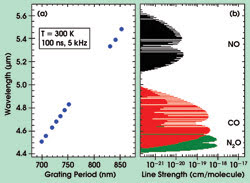
Figure 3. (a) Pulsed (100-ns pulse width, 5-kHz repetition rate) emission wavelengths of single-mode distributed feedback quantum cascade lasers at a heat sink temperature of 300 K are graphed versus distributed feedback grating period. (b) The line strength versus wavelength of CO, N2O and NO calculated from the Hitran96 database shows a good match between emission wavelengths and maxima of the fundamental rotational-vibrational transitions of the gases.
As an illustration of the spectral range covered by single-mode quantum cascade lasers fabricated at Fraunhofer IAF, Figure 3a shows the emission wavelength versus the period of the distributed feedback grating. The devices were operated in pulsed mode (100-ns pulse width, 5-kHz repetition rate) at a heat sink temperature of 300 K and with a side mode suppression ratio greater than 27 dB. As can be seen from the absorption line strength calculated from the Hitran96 database (Figure 3b), the emission wavelengths match well the maxima of the fundamental rotational-vibrational transitions of carbon monoxide, nitrous oxide and nitric oxide centered in the 4.6- to 5.4-μm wavelength range.
The laser’s wavelength is tuned by adjusting the temperature of the heat sink or by applying current pulses to the laser. Typical temperature tuning rates of our GaInAs/AlInAs/InP-based lasers are about –0.14 cm–1/K at 2000 cm–1 (5-μm emission wavelength), dropping to about –0.07 cm–1/K at 1000 cm–1 (10 μm). This means that when operated on a thermoelectric cooler between 250 and 350 K, a wave-number range of typically 14 cm–1 can be covered at 2000 cm–1 (or 7 cm–1 at 1000 cm–1).
Sensing applications
In mid-IR absorption spectroscopy, a beam of infrared radiation passes through the sample, and the amount of transmitted radiation is detected, from which the absorption strength can be computed (Figure 4). To record a spectrum, the wavelength of the laser is tuned across the spectral range, and the absorption is plotted as a function of wavelength. Both the chemical composition and the concentration of the gas or gases in the cell can be inferred from this plot.

Figure 4. Laser spectroscopy with a quantum cascade laser involves passing the tunable, narrowband radiation through a sample and observing the transmission as a function of wavelength.
At Fraunhofer Institut für Physikalische Messtechnik (IPM), also in Freiburg, we have developed a compact and reliable gas measurement system in which the quantum cascade laser is tuned entirely with thermoelectric cooling. The modular system can be configured for both single- and multipass cells ranging in size from 10 cm to 200 m. The laser pulses have durations of between 50 and 200 ns, and during a pulse, the frequency can be tuned across a wave number, which usually is sufficient for the measurement of a spectral line.
Typical laser pulses recorded are shown in Figure 5: the top in the absence of NO, and the bottom with NO present. Because the laser is tuned across its wave-number spectral range during the pulse, the difference between the two curves yields the optical absorption spectrum of the gas. The gas concentration is given by integration over the calculated absorption.
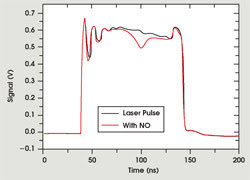
Figure 5. The laser is scanned across a wave number during its ~100-ns pulse duration, so the difference between the two transmitted pulses provides sufficient information about NO’s absorption spectrum to identify the gas and to gauge its concentration.
As another example application, the gas measurement system can monitor ambient air in chemical plants. Researchers at Fraunhofer IPM have used the system with a 10.33-μm quantum cascade laser to detect NH3 over a 1.5-km range.
Two or more gases also may be analyzed, although a wider tuning range (perhaps up to three wave numbers) usually is required. This is achieved by the rapid heating of the active zone of the quantum cascade laser, and we have succeeded in tuning lasers as much as five wave numbers by extending their pulse duration to 1 μs.
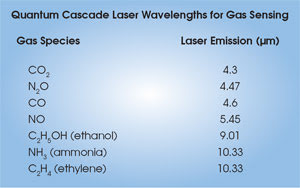 Many other gases can be detected by swapping the quantum cascade laser in the system. We have measured CO2 concentrations with a 4.3-μm laser in the system, and CO concentrations with a 4.6-μm device. Several other gases, and the wavelength of the appropriate laser, are shown in the table (page 76). Other gas-sensing applications of these lasers being explored in laboratories around the world include the monitoring of combustion processes by the automotive industry and diagnostic medical issues, such as breath analysis.
Many other gases can be detected by swapping the quantum cascade laser in the system. We have measured CO2 concentrations with a 4.3-μm laser in the system, and CO concentrations with a 4.6-μm device. Several other gases, and the wavelength of the appropriate laser, are shown in the table (page 76). Other gas-sensing applications of these lasers being explored in laboratories around the world include the monitoring of combustion processes by the automotive industry and diagnostic medical issues, such as breath analysis.
However, although the quantum cascade laser is a valuable spectroscopic tool, its application is not limited to spectroscopy. For example, initial experiments at Fraunhofer IPM using emitters fabricated at Fraunhofer IAF have established its utility in free-space optical data networks.
The mid-IR region of the lasers has several advantages over the near-IR or visible region occupied by conventional free-space systems. Absorption by water is much lower in the mid-IR, as is scattering by small airborne particles. Thus, rain, snow and fog, as well as dust and sand, pose a smaller problem for these systems. Moreover, because the optical power required to damage the eye is two orders of magnitude greater in the mid-IR than in the eye-safe near-IR, much higher powers can be transmitted safely.
References
1. J. Faist et al (April 22, 1994). Quantum Cascade Laser. SCIENCE, pp. 553-556.
2. Ch. Mann et al (2003). Quantum Cascade Lasers for the Mid-infrared Spectral Range: Devices and Applications. Advances in Solid State Physics. Vol. 43. B. Kramer, ed. Springer-Verlag Heidelberg, pp. 351-368.
Meet the authors
Christian Mann ([email protected]) is a postdoctoral researcher, and Joachim Wagner ([email protected]) is head of the optoelectronic materials department at Fraunhofer Institut für Angewandte Festkörperphysik in Freiburg, Germany.
Ulrike Tauer ([email protected]) is in marketing in process and environmental monitoring, and Marcus Braun ([email protected]) researches electronics, programming and data evaluation at Fraunhofer Institut für Physikalische Messtechnik, also in Freiburg.